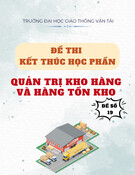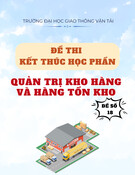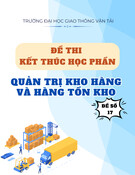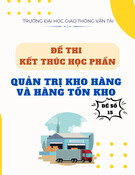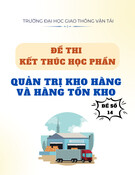
BM-00
TRƯỜNG ĐẠI HỌC VĂN LANG
KHOA: THƯƠNG MẠI
ĐỀ THI VÀ ĐÁP ÁN ĐỀ THI KẾT THÚC HỌC PHẦN
Học kỳ 3 , năm học 2021 - 2022
Mã học phần: 213_7TM0090
Tên học phần: Logistics Quốc Tế
Mã nhóm lớp học phần: 213_7TM0090_01
Thời gian làm bài (phút): 75
Hình thức thi: Trắc nghiệm và tự luận (Đề mở)
Giảng viên nộp đề thi, đáp án bao gồm cả Lần 1 và Lần 2 trước ngày 30/6/2022.
Format đề thi:
- Font: Times New Roman
- Size: 13
- Tên các phương án lựa chọn: in hoa, in đậm
- Không sử dụng nhảy chữ/số tự động (numbering)
- Mặc định phương án đúng luôn luôn là Phương án A ghi ANSWER: A
PHẦN I: TRẮC NGHIỆM (7.5 điểm, gồm 25 câu, mỗi câu 0.3 điểm)
What is a supply chain?
A. A supply chain consists of all stages involved directly or indirectly, in
fulfilling a customer request.
B. A supply chain consists of all stages involved directly in fulfilling a customer
request.
C. A supply chain consists of all elements that contribute to the continuous supply
of goods to companies
D. None of the answers.
ANSWER: A
The objective of Supply Chain Managment is
A. To coordinate activities within the supply chain to maximize the supply
chain’s competitive advantage and benefits to the ultimate consumer.
B. To coordinate activities within the supply chain to maximize the profit and
payout to the shareholders.
C. To ensure that all supply chain opperations perform smoothly no matter the cost.
D. To ensure that the cost of each supply chain operation is as low as possible.

BM-00
ANSWER: A
The objective of Supply Chain Managment is
A. To coordinate activities within the supply chain to maximize the supply
chain’s competitive advantage and benefits to the ultimate consumer.
B. To coordinate activities within the supply chain to maximize the profit and
payout to the shareholders.
C. To ensure that all supply chain opperations perform smoothly no matter the cost.
D. To ensure that the cost of each supply chain operation is as low as possible.
ANSWER: A
The following statement is true or false: “Most of the times the entities of a supply chain
will have different objectives and these objectives can conflict with each other”.
A. True
B. False
ANSWER: A
The three flows of a supply chain is
A. Physical flow, Finance flow, and Informantion flow
B. Physical flow, Informantion flow, and Human resources flow
C. Physical flow, Service flow, and Information flow
D. None of the answers.
ANSWER: A
Which one of these is an input of Logistics Management?
A. Financial Resources
B. Propriety Assets
C. Work-in-progress Inventory
D. None of the answers.
ANSWER: A
Which one of these is NOT an output of Logistics management?
A. Finished goods
B. Competitive advantage
C. Time and place utility
D. Efficient movement to customers.
ANSWER: A
Which one of these is NOT a Logistics activity?

BM-00
A. Product Marketing
B. Customer service
C. Demand forecasting
D. Order processing
ANSWER: A
For the following sale data of the first 6 months in 2021 of a certain store, use an SMA(3)
forecasting method to predict the sales number of July:
Month
Sales
number
(units)
1 610
2 620
3 680
4 650
5 630
6 640
A. 640 units
B. 635 units
C. 650 units
D. None of the answers
ANSWER: A
For the following sale data of the first 6 months in 2021 of a certain store, use a WMA(3)
forecasting method to predict the sales number of July:
Month
Sales
number
(units)
1 590
2 605
3 595
4 615
5 620
6 650
With the given weighting as:
W1 0.5
W2 0.3
W3 0.2
A. 634 units
B. 635 units
C. 623.5 units
D. None of the answers

BM-00
ANSWER: A
The following statement is true or false: “For exponential smoothing forecasting technique,
the smoothing constant (alpha) should be low when the demand is fluctuating and high
when the demand is stable”.
A. False
B. True
ANSWER: A
The following statement is true or false: “For forecasting models, random errors can be
easily modeled and explained”.
A. False
B. True
ANSWER: A
High ratio of volume to weight products with high volume and low price are more likely to
use which of these distribution structures?
A. Manufacturer to cash-and-carry whole seller
B. Manufacturer via small parcels carrier to retail shop
C. Factory direct to home
D. None of the above
ANSWER: A
A product with high substitutability should have a distribution network that:
A. Has high stock levels.
B. Has low stock level.
C. Uses low cost transport modes.
D. None of the above
ANSWER: A
The timeframe of Strategic supply chain planning is
A. 5 to 10 years or more.
B. Between 1 to 5 years.
C. Between 3 to 6 months.
D. None of the above
ANSWER: A
The focus of Operational supply chain planning is:

BM-00
A. Efficiency
B. Competition
C. Resources
D. None of the above
ANSWER: A
In the case of a high volume, low variety product in a predictable environment, which type
of supply chain is prefered?
A. A Lean supply chain
B. An Agile supply chain
C. A Fast suppy chain
D. None of the above
ANSWER: A
The logistics focus of Lean supply chains is:
A. Eliminate waste
B. Customers and market
C. Fluid clusters
D. Stable planning
ANSWER: A
According to Fisher’s approach (1997), the root cause of problems in supply chain is
A. The mismatch between the type of product and the type of supply chain
B. The mismatch between the type of product and the main transportation mode.
C. The mismatch between the type of supply chain and the the main transportation
mode.
D. None of the answers
ANSWER: A
A potential benefit of postponement strategy
A. Low risk of unsold items
B. Lower ordering cost
C. Shorter leadtime
D. None of the answers
ANSWER: A
The Continuous inventory system is one where:
A. None of the answers


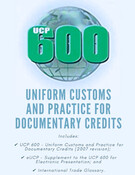
![Đề thi Quản trị Logistics và chuỗi cung ứng quốc tế học kì 2 năm 2024-2025 có đáp án [Mới nhất]](https://cdn.tailieu.vn/images/document/thumbnail/2025/20250915/kimphuong1001/135x160/59591757927414.jpg)

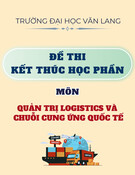


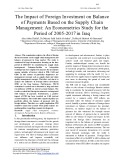

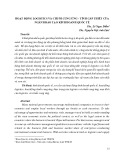






![Đề kiểm tra Quản trị logistics [mới nhất]](https://cdn.tailieu.vn/images/document/thumbnail/2025/20251015/2221002303@sv.ufm.edu.vn/135x160/35151760580355.jpg)
![Bộ câu hỏi thi vấn đáp Quản trị Logistics [năm hiện tại]](https://cdn.tailieu.vn/images/document/thumbnail/2025/20251014/baopn2005@gmail.com/135x160/40361760495274.jpg)
